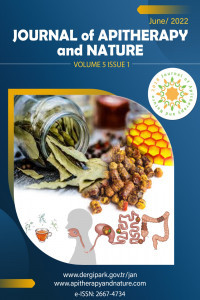Application of Propolis – Herbal Ethanol Extract and Ointment for a Leg with Gangrene (Clinical Case)
Application of Propolis – Herbal Ethanol Extract and Ointment for a Leg with Gangrene (Clinical Case)
Propolis Bulgarian folk medicine,
___
- .
- Yayın Aralığı: Yılda 2 Sayı
- Başlangıç: 2018
- Yayıncı: Oktay YILDIZ
Erzsébet-timea DOMOKOS, Adriana URCAN, Liviu Alexandru MARGITAS, Daniel Severus DEZMIREAN, Otilia BOBIS
Isolated Triterpenes from Stingless Bee Lisotrigona furva Propolis in Vietnam
Le Nguyen THANH, Vu Thi Kim OANH, Ha Thi THOA, Diep Thi Lan PHUONG, Nguyen Thi Phuong LIEN, Tran Huu GIAP, Nguyen Thi Minh HANG, Nguyen Van HUNG, Vassya BANKOVA
ARC (Apiceutical Research Centre): Exploring a New Generation of Medicines from the Beehive
Ahmad SULAEMAN, M MAHANI, HARDINSYAH HARDINSYAH, E DARMA, S. R. MUBAROKAH, N NURJANAH
New Antiproliferative Acyl Glycerols from New Zealand Propolis and Source Poplar Resin
Stephen BLOOR, Owen CATCHPOLE, Kevin MITCHELL, Rosemary WEBBY
What We Know, and Don't Know, about the Benefits of Propolis to Honey Bee Health
Quantitative and Qualitative Variations in Propolis Collection
C. TANANAKI, A. THRASYVOULOU, D. KANELIS, V. LIOLIOS
Soumaya TOUZANI, Sleman KADAN, Abdalsalam KMAIL, Bashar SAAD, Badiaa LYOUSSI
Propolis: Pharmacological Properties and Medical Applications of Propolis in Modern Medicine
